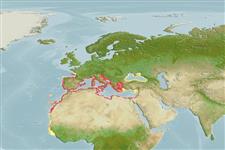>
Blenniiformes (Blennies) >
Blenniidae (Combtooth blennies) > Salariinae
Etymology: Parablennius: Greek, para = the side of + Greek, blennios = mucus (Ref. 45335).
Environment: milieu / climate zone / نطاق العمق / distribution range
البيئة
بحري; مياه مخلوطة القاع; نطاق العمق 3 - 15 m (Ref. 5981). Subtropical; 47°N - 9°N, 19°W - 42°E
Eastern Atlantic: coast of Portugal, Spain and Morocco south to Guinea. Also in all parts of the Mediterranean (except Syria, Lebanon, Israel and Egypt), in the Sea of Marmara and the Black Sea, and Canary Islands (Ref. 5981).
الحجم / وزن / العمر
النضج: Lm ? range ? - ? cm
Max length : 15.0 cm TL ذكر/ مختلط الجنس; (Ref. 3397)
وصف مختصر
مفاتيح التعريف | الوصف الخارجي | قياسات المظهر الخارجي
Facultative air-breathing in the genus (Ref. 126274); Adults occur over sandy bottoms with boulders and light vegetation. They hide in crevices where the nests are being guarded by the male (Ref. 5981). Oviparous. Eggs are demersal and adhesive (Ref. 205), and are attached to the substrate via a filamentous, adhesive pad or pedestal (Ref. 94114). Larvae are planktonic, often found in shallow, coastal waters (Ref. 94114).
Life cycle and mating behavior
النضج | التكاثر | وضع البيض | بيض | الخصوبة | Larvae
Oviparous (Ref. 205). Several females visit the hole to spawn with the resident male which guards the nest (Ref. 5981).
Bath, H., 1990. Blenniidae. p. 905-915. In J.C. Quero, J.C. Hureau, C. Karrer, A. Post and L. Saldanha (eds.) Check-list of the fishes of the eastern tropical Atlantic (CLOFETA). JNICT, Lisbon; SEI, Paris; and UNESCO, Paris. Vol. 2. (Ref. 5298)
IUCN Red List Status (Ref. 130435: Version 2025-1)
استخدامات بشرية
مصائد: غير ذات اهمية; حوض مائي: تجاري
أدوات
تقارير خاصة
Download XML
مصادر علي الأنترنت
Estimates based on models
Preferred temperature (مرجع
123201): 16.1 - 21.7, mean 19.2 °C (based on 643 cells).
Phylogenetic diversity index (مرجع
82804): PD
50 = 0.5000 [Uniqueness, from 0.5 = low to 2.0 = high].
Bayesian length-weight: a=0.00851 (0.00489 - 0.01483), b=2.90 (2.75 - 3.05), in cm total length, based on LWR estimates for this species & Genus-body shape (Ref.
93245).
مستوى غذائي (مرجع
69278): 3.3 ±0.3 se; based on diet studies.
المرونه (مرجع
120179): عالي, الحد الزمني الأدني لتضاعف عدد أفراد المجتمع أقل من 15 شهر (Preliminary K or Fecundity.).
Fishing Vulnerability (Ref.
59153): Low vulnerability (10 of 100).
🛈
Nutrients (Ref.
124155): Calcium = 115 [19, 351] mg/100g; Iron = 1.38 [0.53, 4.36] mg/100g; Protein = 4.03 [0.31, 7.75] %; Omega3 = 0.443 [0.188, 1.034] g/100g; Selenium = 9.83 [2.13, 28.31] μg/100g; VitaminA = 21.6 [8.6, 54.4] μg/100g; Zinc = 1.25 [0.60, 2.47] mg/100g (wet weight);
